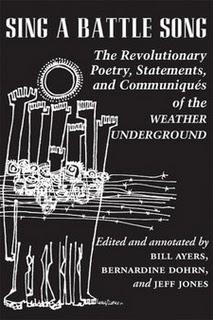Sing a Battle Song: The Revolutionary Poetry, Statements, and Communiqués of the Weather Underground, 1970-1974

Between 2002’s documentary The Weather Underground and such novels as Russell Banks’s The Darling, the radical revolutionary group ironically returned to the public eye in recent years. Thirty years after their underground activities ended, now that all the charges have been dropped and all of the living members of the organization have joined the establishment, albeit on the fringes (Dohrn, Ayers and Jones have become a legal scholar, an educational philosopher and an environmental activist respectively), Sing a Battle Song offers a complex, bittersweet perspective on The Weather Underground’s life and revolutionary work.
Sing a Battle Song is an anthology containing three volumes of work by the Weather Underground: the original Sing a Battle Song, an anthology of poetry by Weatherwomen; The Weather Eye, a collection of communiqués published by the organization to explain individual bombings or denounce government actions; and Prairie Fire, a comprehensive explanation of the organization’s politics. The volume opens with three essays by Dohrn, Ayers and Jones, reach reflecting from his or her own perspective on the accomplishments and failings of the group in its time. Dohrn’s mea culpa are particularly moving—she seems, among the three, to see the precise workings of the organization most clearly.
The poetry in Sing a Battle Song has lost, from this standpoint, most of its power. The poems are published without individual author credit, simply as the work of Weatherwomen. While this makes a powerful statement about organizational solidarity, the poems themselves, without the immediacy of their political context, seem tame. However, The Weather Eye, the communiqués themselves, presents the era in a vivid, visceral fashion. This middle section is the most powerful in the book; it’s harsh, honest, and powerfully written, expressing the goals and thoughts of the movement neither bogged down by theory nor by unnecessary flourish.
The anthology, in the end, is most compelling and disturbing as a historical document, an observation of what the countercultural and revolutionary movements of the 1960s and 1970s did or did not accomplish. Some aspects of the work, like the unflagging support of Fidel Castro in Prairie Fire, seem downright naïve and misguided from this perspective; most of their observations about corporate culture and control, however, remain depressingly resonant today.
I would like to correct the assertion in this review that "all of the living members of the organization [the Weather Underground have joined the establishment..."David Gilbert is a US political prisoner who was a member of the Weather Underground.The following information was found at http://www.kersplebedeb.com/mystuff/profiles/gilbert.html"The Civil Rights struggle of the 60s exposed David to the sham of US democracy and embodied the beauty of collective struggle. In 1965 he started the Vietnam Committee at Columbia University in NY and became a founding member of Students for a Democratic Society (SDS) there. In 1967, David authored the first SDS pamphlet on US Imperialism and participated in the Columbia Strike of 1968. After about 5 years of organizing in the above ground movement, David joined the revolutionary underground, spending a total of 10 years living clandestinely, actively resisting imperialism with arms. On October 20, 1981, he and other comrades were captured at Nyack, NY during an attempted expropriation by a unit of the Black Liberation Army working with white revolutionaries (known as the Revolutionary Armed Task Force- RATF). During the expropriation attempt, 3 officers were killed. Charged and convicted of felony murder, David is serving a 75 year (minimum) to life sentence.While in prison, David has been actively involved in the struggle against AIDS, and has remained a staunch opponent of oppression still dedicated to human liberation. He is also a longtime adviser and collaborator in the annual Free Political Prisoners Calendar project."